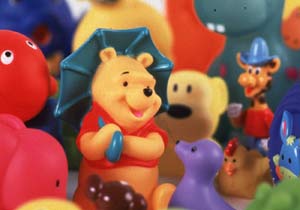
PVC toys
PVC (both soft and hard) is one of the most widely used types of plastics. It is used for packaging in cling film and bottles, for consumer products such as credit cards and audio records, for construction in window frames and cables, for imitation leather, and around the home in pipes, flooring, wallpaper and window blinds. It is used by manufacturers for car interiors, in hospitals for medical disposables...and many more things.
During the production of PVC, dioxins, some of the most toxic chemicals known, are created and released. Over their lifetime, PVC products can leak harmful additives. Furthermore, at the end of their lifetime, PVC products must be either burned or buried. Burning creates and releases more dioxins and other chlorine-containing compounds that contaminate our land and waterways. Attempts to recycle PVC have proven difficult, so much of it ends up in landfills.
Chemicals, such as phthalates, are added to PVC to make it soft and flexible. Laboratory studies in animals show that some of these chemicals are linked to cancer and kidney damage and may interfere with the reproductive system and development. In addition, recent testing by several governments concludes that children can ingest hazardous chemicals from PVC toys during normal use.
Governments and industry are taking action to eliminate the PVC threat. The Danish and Swedish governments are restricting PVC use. Hundreds of communities around the world are eliminating PVC in buildings. And many companies such as Nike, IKEA and The Body Shop have committed to eliminating PVC from all their products.

